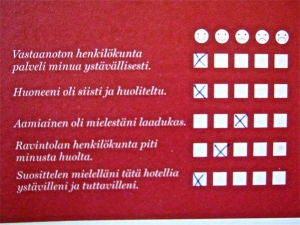EDIT: looking for a more up to date test day experience? My friend, Alexandra, took the test in 2017. Here is her account: YKI Keskitaso 08.04.2017
Yesterday (11.04.2015), along with around 50 others, I took the YKI testi, keskitaso level, in Joensuu.
We began with the tekstin ymmärtäminen paper which lasted 1 hour. There were 24 questions which were either true/false or A/B/C and 3 texts where you had to write sentences in answer to the questions (about 3 questions/text). All the texts were under 1 page and some were only about 10 lines. We had a small news item about an escaped lisko, an advert from a bike repair shop, a text giving advice about pipes freezing (!) and some others. I think there were 6 texts in all. (Amazing how much I’ve forgotten about the texts since yesterday! Must have been the stress!). I found the time very generous, easily enough time to read all the texts and questions and copy the T/F and A/B/C answers onto the answer sheet.
Next, after a 10 min break, came the kirjoittaminen paper which lasted 55 minutes. The time went fast and I was a little worried that I wouldn’t have enough time but in the end It was ok. The tasks were as follows:
- 1 letter to an yhdistys (organisation) saying that you’d like to volunteer with them
- 1 email to your building committee’s puheenjohtaja (chairperson) about an upcoming kokous (meeting)
- 1 opinion piece for an internet forum, choice of 2 topics: I chose oma asunto vai vuokra-asunto?
Both the first two tasks had very clear instructions and bullets points about what to include so it was easy to structure the letter and email and to employ the ‘trick’ of using the words in the instruction bullet points in my writing. Both had the reminder muista aloitus ja lopetus. The mielipideaihe however did not give detailed instructions what to include ie it did not, as in our practice papers, say how many justifications (perusteita) we had to give for our opinion only that we should perustella sinun mielipideesi hyvin. So, for me, it was hard to structure my answer as I wasn’t sure how much to write!
After an unnecessarily long break of 1/2 hour my group went into the kielistudio to do the puheen ymmärtäminen and puhuminen parts of the test. For me the puheen ymmärtäminen was quite challenging. Unlike the practice exercises I had done in class and online the people I was listening to spoke extremely quickly using slang terms. Also, unlike in practice, there were no adverts or simple announcements (bar one informal announcement given by a coach driver during a coach trip) in the test – we were just listening to people talking! The questions again took the form of true/false, A/B/C (20 questions) and written answers. We often had to write 2 things in answer to one question. The time given for reading the questions and choosing the answers after listening was, for me, sufficient. This part seemed to be over very quickly.
Whenever I have practiced for the puhuminen part of the test (Hanna will attest to this!) I normally have trouble filling the allotted time to speak and trail off into silence. I was dreading having to talk for 2 minutes during the mielipide monologues part of the test but, perhaps it was the stress, the time flew by and I talked non stop, occasionally getting cut off! I hope this is/was a good thing…Although what I was saying might well have been mostly nonsense! The puhuminen test included:
- A phone call to the police to report your bike stolen
- a phone call to sort out an unpaid phone bill
- 4/5 25 second tilanteita including asking your neighbour for help moving some furniture, telling a department store you’d left something behind there (in both cases you had to keksi itse mitä)
- a monologue about men and women’s work and roles at home (there was a choice of two topics for this part)
- a monologue about visiting people and people visiting you (who visits? How often? What do you offer them to eat and drink? etc) (no choice you had to speak about this!)
So. it’s over. I feel quite flat and deflated today and it’s weird not to feel compelled to spend every bit of spare time practicing for the test! I should get the results in about 2 months’ time and of course I’ll post about them! But, for now, it’s “Näkemiin!” from me.



